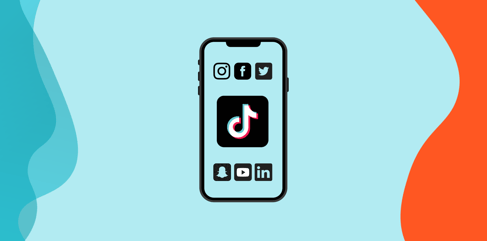
Written By:
Tamara Day
As Instagram continues to be a top platform for college students, universities are able to utilize the social channel in various ways. For example, with the help of its current students, colleges are using Instagram as a marketing tool to attract prospective students. At the same time, social media is also a powerful way to engage with current students in higher education.
Though most enrollment marketers are familiar with user-generated content, not all are educated on how to use it effectively. So, how do we use user-generated content effectively for our institution?
Here we’ll discuss how higher education marketers can use user-generated content on social platforms like Instagram to support their marketing goals. Some key points we’ll touch on include:
- What user-generated content is
- Why user-generated content is successful
- How universities manage student access to their account
What Is User-Generated Content?
User-generated content (UGC) is any form of content created by individuals that’s then published to an organization’s online or social network. It establishes trust between a customer and a brand—or in this case, a student and an institution. It can attract prospective students by promoting a college’s various offerings with current students’ content. Many universities already incorporate user-generated content on their social channels, but many are unaware of its use as a marketing tool.
Why Is User-Generated Content Successful?
User-generated content is all about building trust in an authentic, reliable, and credible way. In higher education, this means posting current student snapshots to show viewers what they can expect from life at your school. There’s nothing more genuine than a college student recounting their honest experience. Offering content that shows current students benefiting from your programs can only help in prospective students’ decision-making process
According to HubSpot, here are just a few advantages of leveraging user-generated content on social media:
- Helps brands understand their target audience better
- Improves site engagement and time spent on the website
- Increases customer satisfaction through conversations
- Boosts the brand’s search engine ranking and online visibility
- Requires peer review, making it more trustworthy
User-generated content is also a great way for institutions to differentiate themselves from their competitors. Though similar content can be created and used, your community is inherently unique. With students creating content that represents their school pride, it gives prospective students an insight into your university.
How to Find Students to Represent You
Once you know what type of user-generated content you want to post, deciding who should represent your school is the next step. Finding students who are passionate enough about the community to continuously post on your social media platform(s) can be difficult. One way you can reach out to these students is attending club and organization meetings, campus-wide events, and academic honor programs. Those kinds of students are often more likely to take on additional responsibilities and participate in school promotion.
What Type of Content Should You Post?
Understanding what type of content your current and prospective students engage with the most is important. This sets the foundation for building a social media presence and profile specific to your target audience.
High Point University provides a great example of how to take advantage of user-generated content. Their TikTok account is filled with videos operated by students, which consist of content such as “a day in their life” and “what I eat in a day” for both students and student-athletes. Although High Point’s content was posted on TikTok rather than Instagram, this format is exactly the type of content you should consider for your Instagram marketing strategy.
@highpointu Day in the life of @wtmab #highpointuniversity #hpu #dayinthelife #edutok #college #campus ♬ The Island Paradise - ZydSounds
@highpointu Day in the life of student and freshmen baseball player Easton LaPlaca! #highpointuniversity #dayinthelife #collegelife #studentathlete #d1 #collegebaseball ♬ Hip Hop with impressive piano sound(793766) - Dusty Sky
Content can be repurposed from one platform to another as well. It’s important to be sure that your content is universal to all social platforms your institution uses. Doing so ensures your content reaches the majority of your students—all taking in the same information. For example, a six slide carousel on Instagram can be repurposed into a three minute TikTok or a six minute YouTube video. Taking the time to expand and repurpose your content on multiple platforms is a key way to reaching your target audience.
In our Social Media Publishing Checklist you will find:
- Pre- and post-publishing do’s and don'ts
- Specific tips for various platforms such as Instagram, Facebook, TikTok, LinkedIn, Twitter, and YouTube
- Questions to ask and answer when publishing and analyzing your content
How to Encourage Students to Create Content
At most universities, students and student ambassadors who receive work study have the option of working for the school’s social media team. They are either offered a paycheck or other incentives including school merchandise, technology for content-creation, and college credit.
Managing your student workers can be challenging. Throughout the semester, students may lack motivation to create content due to an increased workload or semester slump. What can you do to prevent this?
One example of how institutions can keep up morale is by offering student ambassadors a scholarship incentive. Throughout the semester, students can follow a point system based on the quality and effort of their content. At the end of the semester, whoever has received the most points can win a scholarship. By having students compete for a prize, it encourages more engagement and passion in their work.
How to Supervise Student Takeovers
Student takeovers are a great way to utilize user-generated content. Institutions may struggle with the idea of a student being exposed to private information regarding the main university account. Others may be concerned with the type of content students are putting out there. From what to post, to what’s applicable, to what content may be offensive to others, social media teams try to engage students while balancing the various factors that could affect the school’s reputation. So, how do universities deal with this?
Holding students accountable is one of the most effective ways to supervise those on your social media marketing team. You can achieve this by:
- Having students sign a liability form
- Providing consequences to students who don’t follow the rules
- Removing students from the program if they don’t meet its standards
Students who willingly create content for the school, aren’t likely going to destroy your school’s reputation or take advantage of the power their posts hold. Though these chances are low, always remember that your institution is ultimately responsible for everything posted to your pages—including student content. Therefore, holding students accountable is the insurance you need to ensure nothing bad happens.
Key Takeaways
User-generated content is a key marketing tool for higher education institutions. Keep in mind, your success depends on your preparation. Knowing how to manage your student-created content is essential for success.
By first understanding what user-generated content is, you can then learn why it’s successful within higher education and how you can use it. Remember, you need to decide what type of content you want on your account before you can choose which students are the best fit for your media team. Don't hesitate to do some research in this department! Once you have your plan, make sure your students are liable for everything they post under the university’s account. User-generated content does not have to be a mystery. By using these guidelines, you should be set up for long-term success!






